-
Posts
2,859 -
Joined
-
Last visited
-
Days Won
19
Content Type
Profiles
Forums
Blogs
Gallery
Events
Store
Posts posted by Claudio
-
-
Hi Gary,
I saw this bar at Illingen (Sammlerb?rse) this June. I was very tempted to buy it, but I knew that a Oberst Schmidt wouldn't be easily researched. But still it's a great piece in mint conditions still attached to the hard paper backing of the juweller/tailor. I think that the asking price was Eur 500.-/550.-.
I am surprised to see that such bars do a lot of travelling around in just a couple of months... first in Germany now in the USA!
Great addition to your collection... my compliments!



Ciao,
Claudio
0 -
Hi guys!
I think you all are wrong.... the first bar is beauuuuuuutiful: it's a bar of a Prussian Lady who changed sex before WWI, got enlisted as simple soldier in a Saxon unit and got the NCO's Prussian PlM, thanks to her/his "Vitamine B" (good network) among the Prussians. After the war she/he went on fighting the communists and poles in several different freikorps. Later she/he became a lady and a Krankenschwester.


It's a very rare combination of one of the first documented lady-man of the history who changed twice sex!!

 Very sexy and rare combination!!!!
Very sexy and rare combination!!!!Ciao,
Claudio
P.S.: this bar is an offense to the serious collecting community. Ebay does a great job: bans everything which comes from the TR period but does notthing against such obvious fakers. That's great!
0 -
Paul,
I considered that, but what if the wearer was merely a civilian and never been in the army? If he had been in the army (at least officer considering the decorations), also in the reserve he should have worn a long service medal of some sort!
Ciao,
Claudio
0 -
@ Paul: Yes, it came from Thies Auction
@ Willi: Could be... but it is not 100% sure. I think, if this bar was of a Diplomat, you would see more decorations. At those times Diplomats received lots of decorations, for every country they visited or they were assigned for. Or he could have been an honory consul in Germany (a lawyer for instance), for England and Russia. Very difficult to know.
0 -
Here's a detailed picture of the last two Foreign orders, as per request.
Ciao,
Claudio
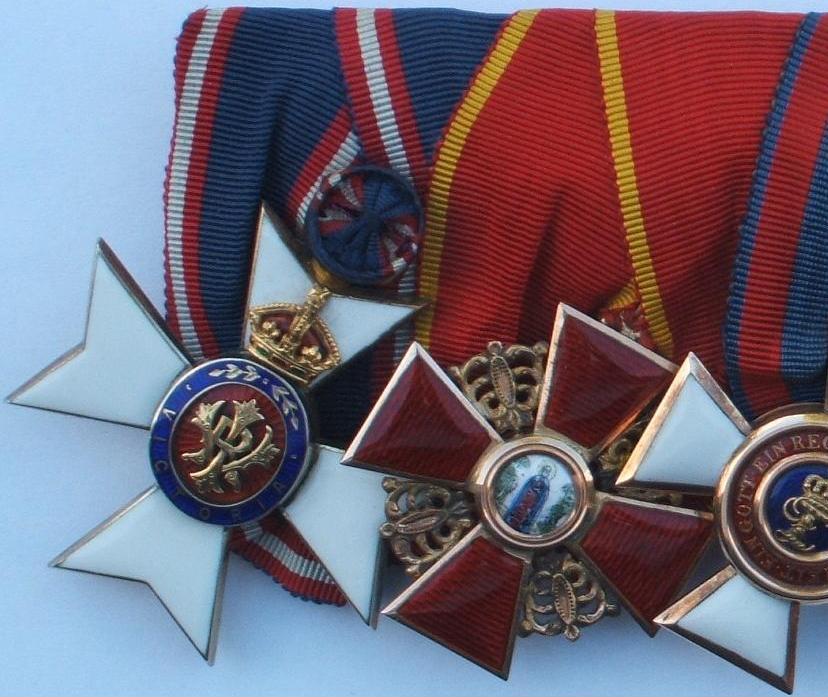

 0
0 -
Thanks Gerd!
Here's a detailed picture of the Iron Cross 2nd class 1870 with Einchelaub 25 and the early version RAO 4th class w/swords.
Ciao,
Claudio
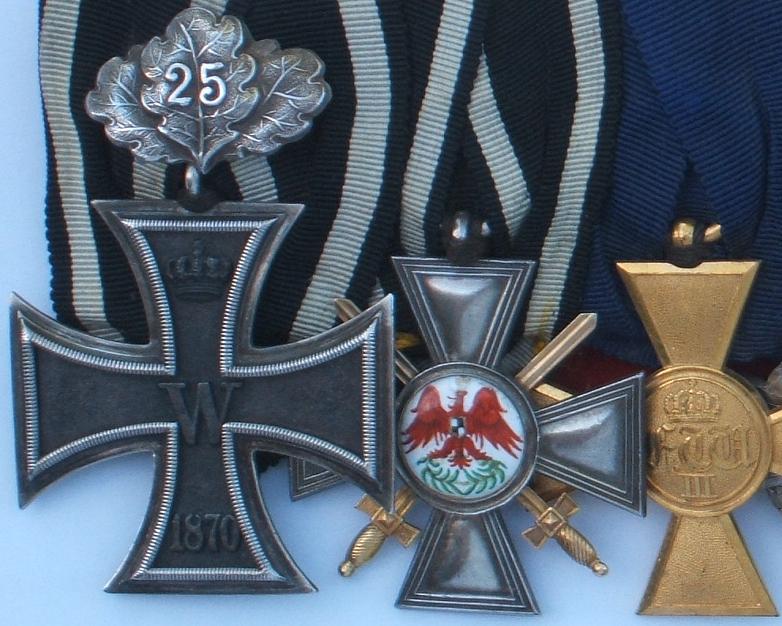
 0
0 -
-
A bigger and better picture of the obverse:
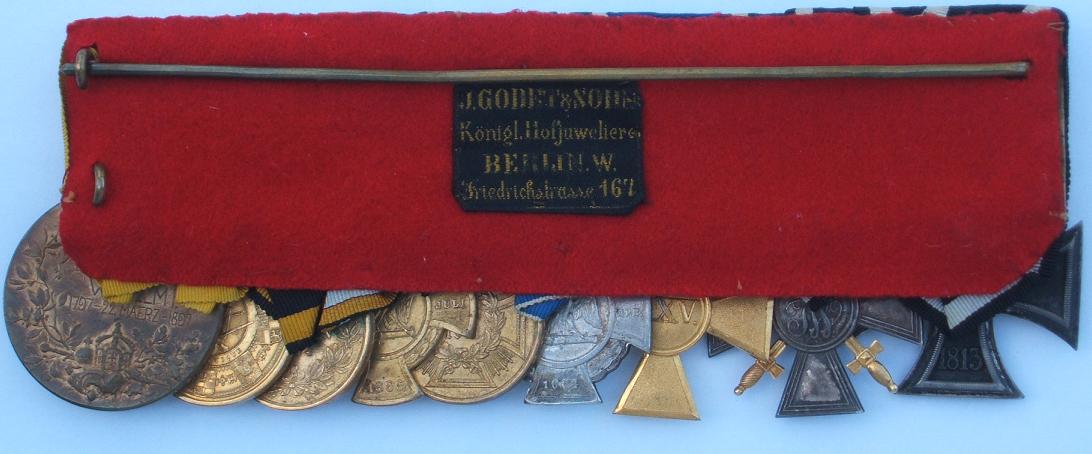
 0
0 -
Dear fellow forumites:
This is the other recent purchase of mine; an unnamed (yet) Frackspange of a Civilian. Notice the beautiful Foreign awards. Maybe this bar can be research since the Royal British Victorian Order (CV=) has a number (308).
Here's the description of the medals:
? Preussen, Roter Adler Orden 4. Klasse, letztes Modell, gek?rnte Arme (OEK 1704)
? Preussen, Kronen Orden 3. Klasse, 2. Modell, Gold und Emaille, Hersteller FR (OEK 1757)
? Oldenburg, Haus- und Verdienstorden Herzog Peter Friedrich Ludwigs, Ritterkreuz 1. Klasse, Gold und Emaille (OEK 1516)
? Russland, St.-Anna-Orden 3. Klasse, Gold und Emaille
? Grossbritannien, K?niglicher Victoria Orden, Ritterkreuz (CVO), Silber vergoldet und emailliert mit Tr?gernummer 308
Also very interesting is the Godet's label on the back with a weird purpore color of the script (woven silk).
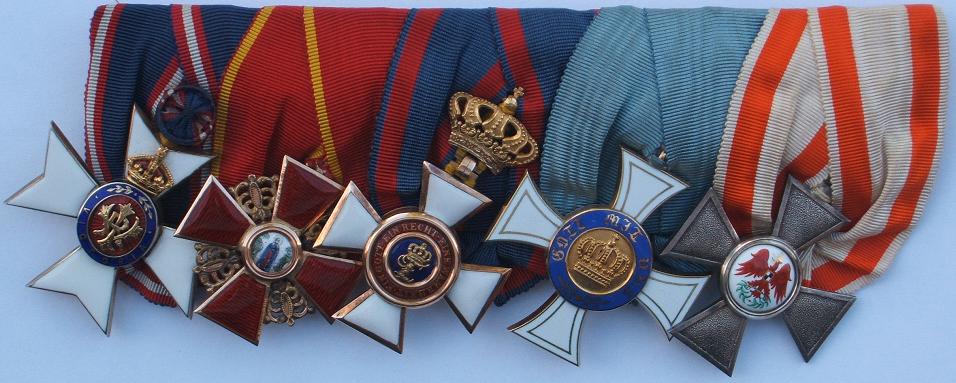
 0
0 -
A bigger picture of the obverse:
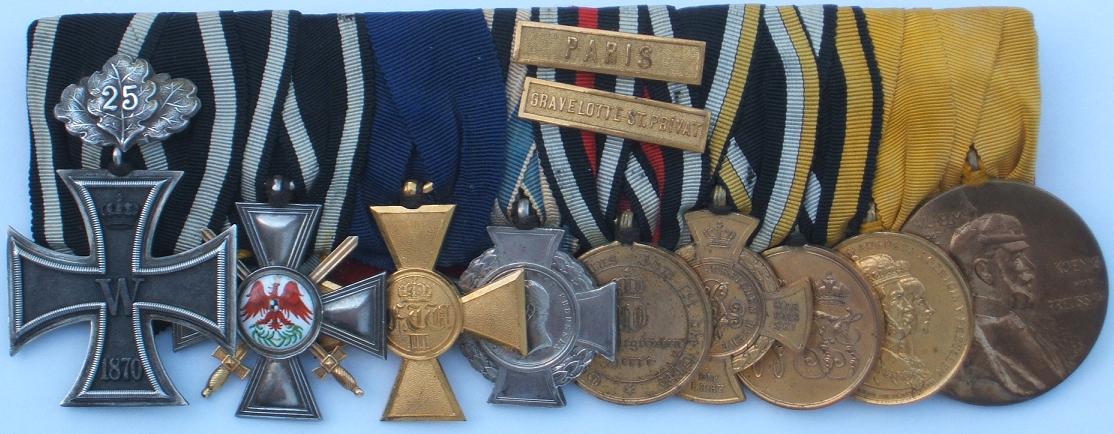
 0
0 -
Dear fellow forumites:
I am proud to introduce to you my newest acquisition, which very likely you have already seen on a recent auction's catalogue.
Here is the Ordensspange of Major von Rheinbaben:
? Preussen, Eisernes Kreuz 2. Klasse 1870 am K?mpferband (OEK 1904) mit Eichenblattspange 1895 ?25? (OEK 1905)
? Preussen, Roter Adler Orden 4. Klasse mit Schwertern, 4. Modell, Ausf?hrung mit glatten Kreuzarmen (OEK 1703)
? Preussen, DA-Kreuz f?r 25 Dienstjahre der Offiziere 3. Modell 1. Typ (OEK 1970)
? Preussen, D?ppeler Sturmkreuz 1864 f?r K?mpfer (OEK 1928)
? Preussen, Kriegsdenkm?nze 1870/71 mit 2 Gefechtsspangen ?Paris? und ?Gravelotte-St. Privat? (OEK 1941/24/7)
? Preussen, Erinnerungskreuz ?K?niggr?tz? 1866 (OEK 1938)
? Preussen, Kriegsdenkm?nze 1864 f?r K?mpfer (OEK 1936)
? Preussen, Kr?nungsmedaille Kaser Wilhelm I 1861 (OEK 1855)
? Preussen, Centenarmedaille 1897 (OEK 1965/1)
Although on the reverse of the bar there was a label put by the previous owner and collector (the deceased Mr. Seymour) stating "Maj. v. Rheinbaben details on file", of course the auctioneer didn't keep the data or at least didn't passed it over to the new owner (me).

If anybody has more details on von Rheinbaben's career I would be most appreciated.
In the meanwhile please enjoy my pictures!
Ciao,
Claudio
P.S.: notice the very old and slightly faded "Hersteller-Etikett" of Godet, dated around the turn of the century, I would guess.
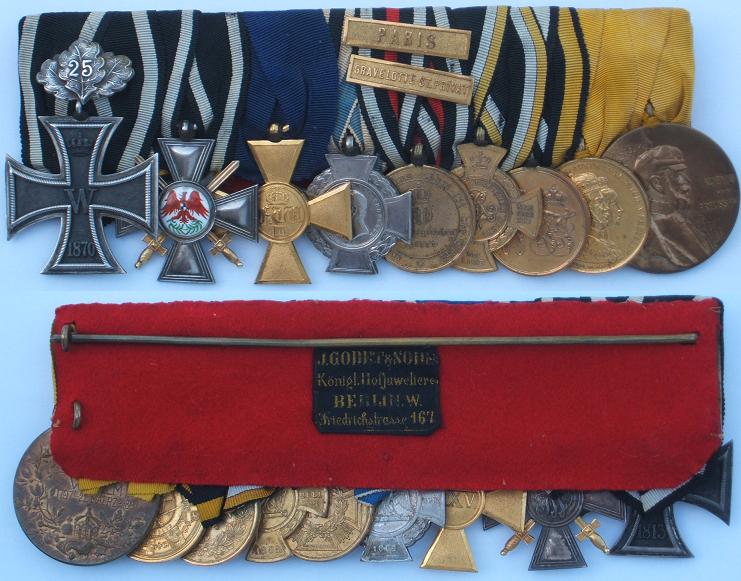
 0
0 -
Hi Willi,
I thought that this bar was put together by a professional dealer of the time (see label of the Milit?r-Effekten Gesch?ft). Very nice!

Ciao,
Claudio
0 -
 Wow! That is a great group!
Wow! That is a great group! 
Herzog Carl Eduard medals with swords and date are extremely desirable and quite rare to find. It seems like your SEHO RK 1. Kl. is made of Gold. Can you also post a picture of the medal bar's reverse? The bar looks being put together from a very professional dealer, like Godet. Not to mention the very rare Eduard-Kriegskreuz! This decoration was given less than 100 times (97 to be precise) and only the recipients of the Iron Cross 1st class!
For all interested parties I am also enclosing the very informative link of Mr. David Danner's site about the decoration of the Duchy of Saxe-Coburg-Gotha:
http://home.att.net/~david.danner/militaria/saxecoburg.htm
I saw one bar like this for sale (with a Carl Eduard medal with swords and dates) on Ebay and one on a Hermann Historica auction. Very nice indeed!!! I am very envious...



Ciao,
Claudio
0 -
... and I don't think the price will be stop increasing... still 8 days to go! It will easily score more than Eur 2'000.-.
Ciao,
Claudio
0 -
Hi Rick,
I thought it would easily (for you at least
 ) researchable this bar.
) researchable this bar.I think I might bid on it. Please, let me know, fellow collectors, who is also interested in bidding on it. I wouldn't like to be involved in a bidding fight with a member of this Gentlemen's club!

Just a side note; I noticed that the OLZ could be a very nice of variant with Golden round medallion and massive eichenlaubs, although from the blurred pictures it is difficult to recognize. What do you think? The Ehrenkreuz of Schwarzburg is also rarely seen on medal bars... very nice! Was that the key of such a "quicky" finding???


Ciao,
Claudio
0 -
Dear fellow Imperial collectors:
This spange is on Ebay:
Roter Adler Orden 4. Klasse mit Hersteller: "N"; Zustand: 1
Dienstauszeichnung (Preussen) f?r 25 Dienstjahre; vergoldet, mit polierten Kanten; Zustand: 1
Centenarmedaille; Zustand: 1-2
Milit?r-Verdienstorden 4. Klasse ohne Schwerter; Hersteller: Jakob Leser; Zustand: Die Emaillierung der Kreuzarme st?rker gechipt!!
Orden vom Z?hringer L?wen - Ritterkreuz 2. Klasse mit Eichenlaub; wundersch?nes altes Modell mit echt goldenem Medaillon; das Eichenlaub ebenfalls aus Gold; Zustand: minimaler Chip im Porzellan, ansonsten ein perfektes St?ck
F?rstlich Schwarzburgisches Ehrenkreuz (Modell f?r Rudolstadt) - Ehrenkreuz 3. Klasse; teilweise emailliert und vergoldet; Zustand: 1
Regierungsjubil?umsmedaille (Baden),1902; Zustand: 1-2
Any comments? Maybe I could be researchable... to bad that the Bavarian MVO is so damaged!
Ciao,
Claudio

 0
0 -
Hi Everybody,
Von Plessen wasn't Ambassador (Botschafter) in Italy but Botschaftsrat, which is something like the no. 2 or 3 (most likely the second one) of a big Embassy.
Here an extrait from Wikipedia, describing this diplomatic title:
Botschaftsrat (engl. Counsellor, frz. Conseiller, span. Consejero) ist die Bezeichnung f?r eine Rangstufe im ausw?rtigen Dienst.
Deutschland
Im deutschen Ausw?rtigen Amt entspricht er einem Beamten der Besoldungsstufe A 15 entsprechend einem Regierungsdirektor in der ?ffentlichen Verwaltung oder einem Studiendirektor an Schulen.
Kommt der Beamte vom Auslandsposten in die Zentrale des Ausw?rtigen Amtes nach Berlin zur?ck, tr?gt er nicht mehr den Titel Botschaftsrat, sondern ist dann Vortragender Legationsrat. Die n?chste Stufe ist die des Botschaftsrats Erster Klasse oder Vortragenden Legationsrats Erster Klasse, was der Besoldungsstufe A 16 bzw. B 3 entspricht. Er ist dann in der Regel Referatsleiter.
An kleineren Vertretungen wie Panama-Stadt oder Ulaanbaatar ist der Botschaftsrat oft der St?ndige Vertreter des Botschafters. Ist dieser abwesend und au?erhalb des Gastlandes, r?ckt der St?ndige Vertreter in die Funktion ? nicht Rang ? des Gesch?ftstr?gers. An gr??eren Botschaften - wie etwa in Washington D.C., Moskau oder bei der St?ndigen Vertretung bei der Europ?ischen Union in Br?ssel - arbeitet eine gr??ere Anzahl von Botschaftsr?ten, i. d. R. als Referenten innerhalb bestimmter Abteilungen (Politik, Wirtschaft, Kultur u. a.).
Von ?http://de.wikipedia.org/wiki/Botschaftsrat?
German Ambassador in Italy was the son of the famous Husaren-Feldmarschall von Mackensen. Here's his biography. His medal bar was sold on Thies auction last year in December.
Hans Georg Viktor von Mackensen (* 26. Januar 1883 in Berlin; ? 28. September 1947 in Konstanz) war ein deutscher Staatssekret?r und Botschafter.
Von Mackensen stammte aus einer bekannten Milit?r-Familie. Sein Vater war Generalfeldmarschall August von Mackensen, sein Bruder General Eberhard von Mackensen.
Hans Georg wurde als Kind zusammen mit Prinz August Wilhelm von Preu?en erzogen, und schlug ab 1902 die Offizierslaufbahn im 1. Garderegiment zu Fu? ein. Die Ausbildung dauerte bis 1907. Parallel dazu studierte er Rechtswissenschaften.
Im Ersten Weltkrieg war von Mackensen pers?nlicher Adjutant von Prinz August Wilhelm, zuletzt als Hauptmann. Nach Kriegsende, war er im preu?ischen Justizministerium t?tig, bis er im Mai 1919 ins Ausw?rtige Amt berufen wurde. In dieser Funktion war er ab September 1923 Gesandtschaftsrat II. Klasse in Rom (Quirinal), und von August 1926 bis April 1929 in Br?ssel. Im Juli 1931 war von Mackensen Botschaftsrat von Madrid. Im Mai 1933 trat er in die NSDAP ein. Ab Dezember 1933 fungierte er als Gesandter I. Klasse in Budapest, bis er am 15. April 1937 als Nachfolger des 1936 verstorbenen Bernhard Wilhelm von B?low zum Staatssekret?r des Ausw?rtigen Amtes ernannt wurde.
Nachdem ihn sein Schwiegervater Konstantin Freiherr von Neurath am 4. Februar 1938 in seinem Amt abl?ste, wurde von Mackensen Nachfolger von Ulrich von Hassell, des wegen seiner Kritik an der Italienpolitik Hitlers zur Disposition gestellten Botschafters von Rom. Am 30. Januar 1942 erhielt er den Rang eines SS-Gruppenf?hrers beim Stab des Reichsf?hrers SS.
In seinem neuen Amt beging von Mackensen jedoch Fehler. So arbeitete er beispielsweise nicht im Sinne Hitlers auf eine baldige Absetzung Mussolinis hin. Aus diesem Grund wurde er am 2. August 1943 ins F?hrerhauptquartier beordert und nach einem Gespr?ch mit dem F?hrer seines Amtes enthoben.
Von Mai 1945 bis April 1946 war von Mackensen in franz?sischer Kriegsgefangenschaft. Ein Jahr nach seiner Entlassung, 1947, verstarb er.
Here's his beautiful medal bar.
Ciao,
Claudio
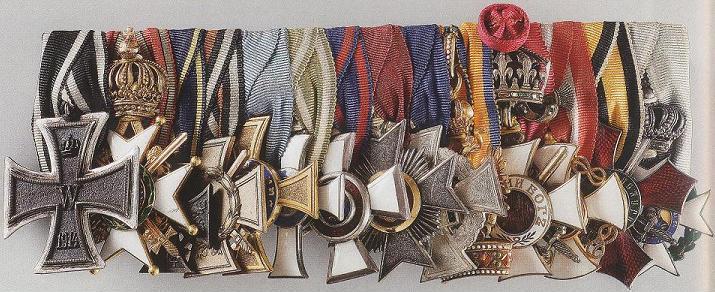
 0
0 -
Hi Willi,
This bar was already discussed on another German forum:
http://www.militaria-fundforum.de/thread.php?threadid=67918
Major Rohe:
Geboren 1875, 1894 "Freiwillig-Gemeiner" 18. IR Prinz Ludwig Ferdinand, Febr. 1899 Leutnant. 1901/02 Einsatz in China, danach altes Regiment, dann 1905 - 1908 S?dwest-Afrika. Wieder altes Regiment, dort 1911 Bef?rderung zum Hauptmann. 1914 - 1916 1. WK, dann wegen schwere Verwundung ausgeschieden, das K?nig-Ludwig-Kreuz wurde verliehen, weil seine Schwester eine Stiftung unter seinem Namen mit einem gr??eren Geldbetrag ins Leben rief. Ab 1918 wieder in der bayerischen Armee aktiv, danach bis 1920 Reichswehr. Dann bis 1939 keine Informationen, wird dann im Winter 1939 Kommandeur eines Baubataillons mit Dienstgrad Major mit Einsatz in Frankreich, knapp 65 Jahre alt, erh?lt die Spange zum EK 2. Klasse am 4.7.1940, danach Ruhestand und stirbt im Jahre 1944.
Ciao,
Claudio
0 -
Hi Stogie,
Prussian DA-Kreuz (where is the Centenar Medaille?) and Bavarian DA-Medaille together? I don't think so. Bavarian Officer with a silberne Verdienstmedaille of Baden? Wouldn't be more appropriate maybe a OZL?
No, no, it makes completely no sense, especially with the KDM 1870-71.

The more I look at it, the less I like it... all wrong!!!
Ciao,
Claudio
0 -
I am by far not a specialist on these breast stars, but if I want to spend that kind of money, it better be an 100% provience proved piece made by an official German jeweller. On the other hand, since these were worn by European nobility who shared common ancestors and lineage, I guess that many of these orders were made also outside Germany, especially the special version such as with the "bandeau" Honi soit qui mal y pense.
Ciao,
Claudio
0 -
Thanks Wild Card!

Yeah! I noticed the Ordenskette of the Guelphen Orden; if you compare the price with the other Prussian Ordenskette, you can say that some of these prices are driven by emotions and collectors' greed ("I have to have it" or "I still miss it in my collection" kind of syndrome).
Ciao,
Claudio
0 -
I got this one... I would love to know more about Major Rheinbaben!!!!

I saw it in Illingen, one month before the auction; it is really in beautiful conditions with an old (1895-1905?) Godet's label on the back. Very nice...

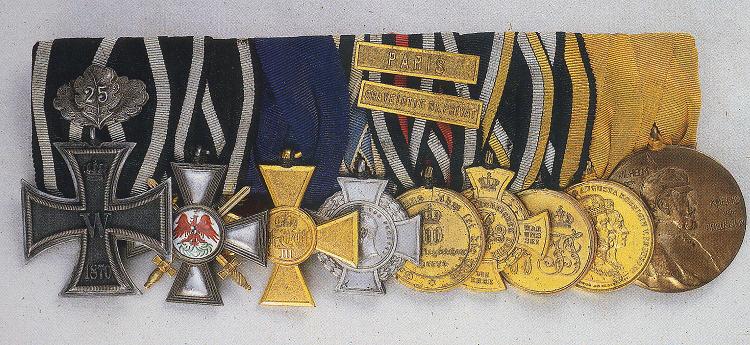
 0
0 -
Guelphen Orden, Ritterkreuz 1. Klasse mit Schwertern (milit?rische Division). Wow...



I was lucky with a couple of bars, but first still need to wait for the invoice to come.
Ciao,
Claudio
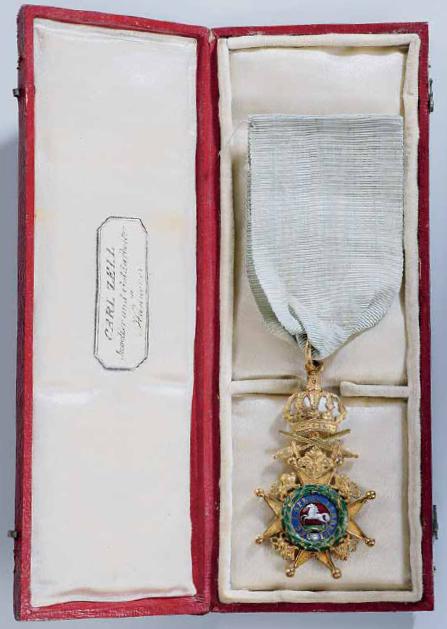
 0
0 -
Yeah, I saw that too Andreas (Art. Nr. 32)! From 1'500.- to 8'300.- Euros!! I was tempted to bid on it, but fortunately I didn't... Did you purchase something nice, if I might ask you?
Historical background to the bestowal of this Ordenskette:

 0
0




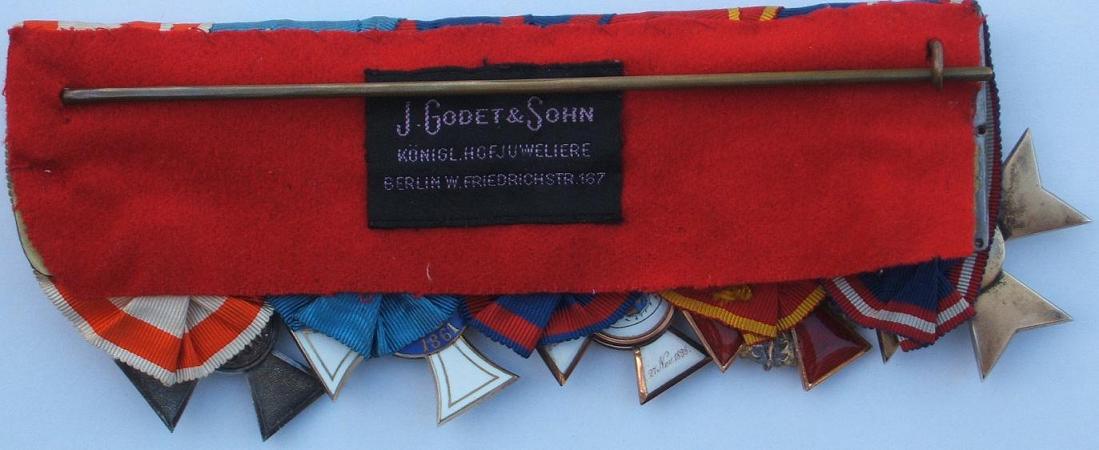
Named Medal Bar
in Germany: Third Reich: Wehrmacht Medals, Decorations & Awards
Posted
Hi M?nster!
Gadly I will stop at your counter next time and say hello to you.
Your partner has been always very fair with prices and his and your pieces have been quite interesting! My brother got a small 2 pieces medal bar last time. I was really very tempted to buy Schmidt's medal bar, but I was saving up for Thies auction.
My brother got a small 2 pieces medal bar last time. I was really very tempted to buy Schmidt's medal bar, but I was saving up for Thies auction.  Sorry!!!
Sorry!!!
Ciao,
Claudio